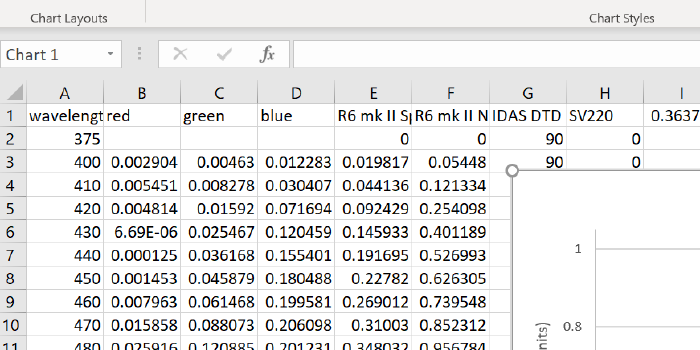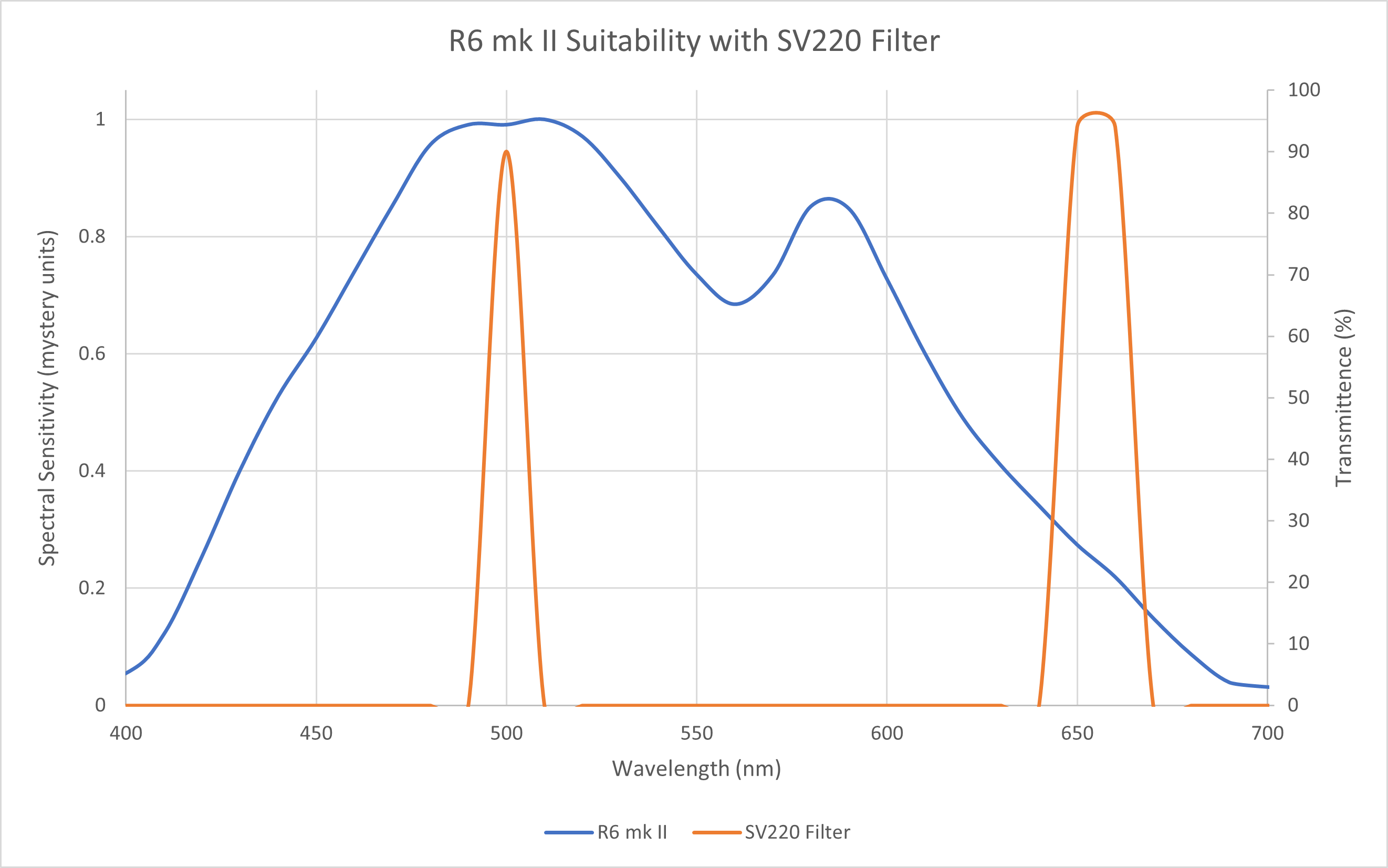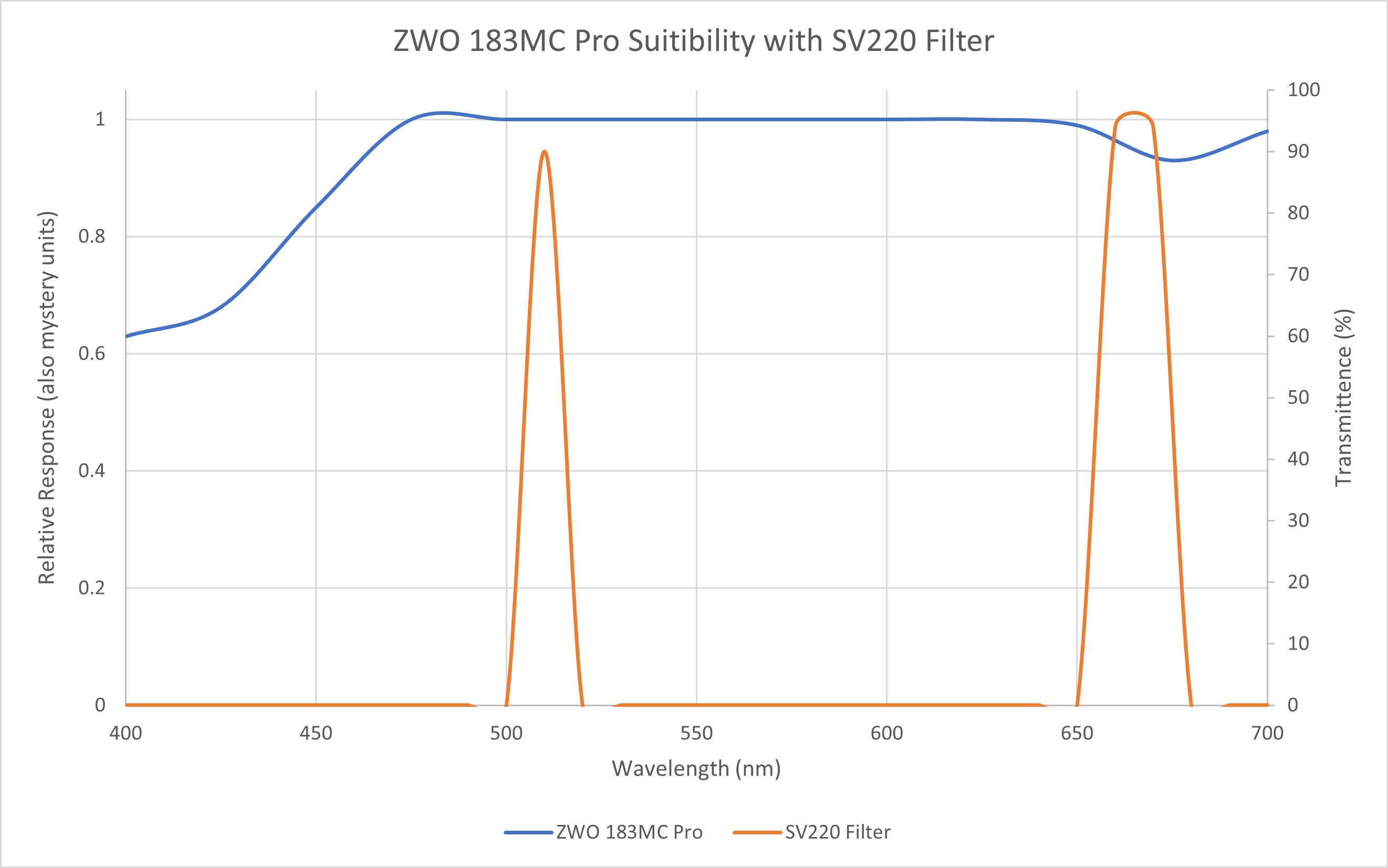Camera Conundrum
DISCLAIMER
I still have no idea what I’m talking about, and the sources in this article are SKETCHY (manufacturers are hesitant to publish real sensor and filter numbers). I’m hoping to write about concepts rather than specifics.
Background
I’m shooting through a boatload of light pollution, and I’ve therefore been happily enjoying my SV220 filter. It works on the principle of only letting tiny slivers of the visible light spectrum through–specifically, those common in emission nebulae. At my budget level, the two emission nebulae sources I can really deal with are Hyrodgen Alpha (around 656 nm) and Oxygen III, (496-501 nm). The SV220 lets those two chunks through and nothing else. Happy days!
Ointment Fly #1
I’ve been intrigued to find most of my pictures appear red, but haven’t worried too much about it because who am I to decide what color cosmic objects are?
My filter is doing a great job of only letting what I want to see through. The thought my friend left me with, though, is whether or not my camera is even capable of sensing those wavelengths.
Turns out…
Looks like my camera can only nab about 30% of what comes through the Hα slice of the filter. DSLRs are (shockingly!) designed to capture visible light, and mine has an IR filter that gets in the way of the Hα line.
Ointment Fly #2
Please don’t ask me to prove any of the following:
Camera sensors introduce various types of noise into every picture. When performing astrophotography, the “signal” (the celestial object, being far away and generally ridiculous to even look at) is very weak. The noise, however, is very strong!
To combat this, you have to take calibration frames and then use those later in processing to subtract out the noise…or pretty much all you’d see is noise.
One of my big challenges has been taking “dark” calibration frames. These are basically taken with the lens cap on (ish). To be useful, they need to be the same ISO, exposure length, and–critically–sensor temperature as the frames taken of the object.
This has led to a few problems:
-
The camera sensor is MANY TEMPERATURES. It starts out cold, then warms up in use, then changes as the air temperature changes…when do I take the calibration darks? At the beginning of the night, in the middle, at the end..? I basically have to choose a temperature in what I think is the middle of the sensor temp range for each session.
-
Since there are so many variables, I have to take calibration frames at the same time as I take the actual images–meaning imaging time is now competing with calibrating time (and as previously whinged about, I don’t have much imaging time to begin with).
-
I didn’t consider this at all when I started. However…since every imaging session needs its own dark frames, I have amassed something like 11 GB of high resolution images of the inside of my lens cap.
Miscellaneous Ointment Flies
-
I have been VERY HESITANT to leave this camera out entirely overnight, especially if there is any chance of dew accumulating
-
I don’t really have a good way to power it other than swapping batteries out and screwing up everything in the process
-
I have another article in mind about this, but the R6 doesn’t play very nice with the ASIAIR computer
The Fix
Dedicated astrophotography cameras solve many problems! I’ve accumulated a used ZWO 183MC Pro.
As far as I can tell by digging around on the internet, it has a much more suitable sensitivity range:
Also, it is a “cooled” camera, meaning the sensor is actively cooled to a desired temperature and held there. I can now take the calibration frames whenever I’d like–for example, on a rainy day…if you can imagine such a thing! Furthermore, I can reuse the same calibration files…and stop accumulating them.
It has an external dew heater, it’s powered by the same battery as the rest of the equipment, and in general should be more suited to the kind of astrophotography I can do around here.
Conclusion
I’m leaving out a lot here, and hope to expand more on this topic soon. Meanwhile, I have really enjoyed the 183MC Pro so far–expect some rad pictures as soon as I figure out what end to aim at space!
PS
Sorry it has been so long. I’m glad to be back!



